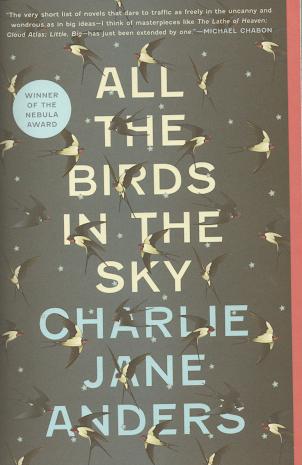First impressions review: All the Birds in the Sky, by Charlie Jane Anders
Apart from being outcasts, childhood friends Laurence and Patricia couldn’t be more different – or so it would seem. Laurence is a tech geek who built a wrist-mounted two-second time machine from cryptic instructions on the internet. Patricia is an outdoorsy type with an (initially) erratic ability to talk to animals who dreams of being a proper witch. While their friendship seemingly falls apart multiple times, they are always drawn back together. But will their relationship save the world, or destroy it?
I thought
this premise was really intriguing, especially since the dynamic between these
characters sounded similar to a pair that I’m writing myself. I
overall enjoyed them both. I did want to smack Laurence more than once, since he has a greater desire
for conventional success and acceptance than Patricia, which can make him a bit
douchey at times – but he redeemed himself by the end. That’s not to say Patricia
doesn’t make mistakes; Perhaps I just found her mistakes more relatable! Their talents combine in interesting ways.
For instance, Laurence built a smart computer in his closet, but it is through talking to
Patricia that it develops into a true artificial intelligence. Their
friends-to-lovers (with a few stops at “sort-of-enemies”) arc is fun. Granted,
I think this would have worked just as well as a best-friends story - a rare
and rather precious thing when it comes to male-female main character pairings!
However, since they are so yin-and-yang compatible they do work as a couple as well. It might have felt a little fresher, though, if their roles had been reversed, especially since in the world of the story their professions aren't gendered: we meet plenty of male witches and female engineers (plus a non-binary person or two).
The writing style is breezy and quirky. I wasn’t sure I liked it at first, because for the childhood portion the modern quippy language, fairy-tale-like episodes, and occasionally really dark moments1 seemed to clash with one another. There’s also an assassin character called Mr. Rose, who is hard to take seriously even though he does some genuinely threatening stuff because of other episodes that make him look goofy. But the style works really well once we get to the ¾ of the book where the characters are in their twenties, hanging out with a lot of hipster types in San Francisco.
1. Patricia’s parents literally lock her in her room for days at one point, sliding food under the door like it’s a medieval dungeon. This seems a bit much considering that she's supposed to mourn them later.
Both Patricia and Laurence end up working for organizations that have mostly good intentions but dangerously skewed perspectives. Laurence’s boss is an Elon Musk type, who assumes that humans are inevitably going to destroy the earth and wants to get us off-world before that happens2. However, that mindset, which values human intelligence above all, runs the risk of destroying the earth even faster! By contrast, witches draw their power from nature. But, since the most powerful become quite isolated from human society, they can easily think up save-the-world plans that are straight-up genocidal!
2. Incidentally, Milton’s “Remind me to look you up on your eighteenth birthday, kid” is the creepiest way ever to say “Come intern for us when you’re actually an engineering student” – which is what he apparently meant!
I like how magic works in this book. It is a fairly “soft” magic system, in that the rules are never fully explained3, but we do learn there are two sides to magic. If you’re a Good Omens fan, you could think of it as the Aziraphale approach versus the Crowley approach. Healer magic isn’t always nice, but it is orderly, and most dangerous when it gets too stuffy and dogmatic. Trickster magic isn’t always bad, but it can get overly chaotic and amoral. The most skillful and powerful witches combine both. I really enjoyed watching Patricia figure out her powers and get creative with them, from (on the same night) improving a party’s vibes and cursing a man who tried to kidnap two girls to run away and forget everything, to reducing an AIDS patient’s viral load, to calling down the lighting to blast a destructive machine to rubble.
3. Though, if anything, the science fiction side is “softer”! No explanation at all is offered for the time machine or Laurence’s antigravity device.
Overall recommendation: If you like approaches to fantasy that are light, quirky, and funny but also have a social message, you would probably like this book. While not quite matching up to ‘The House in the Cerulean Sea’ or the ‘Discworld’ series, this is an enjoyable novel with a similar feel.



